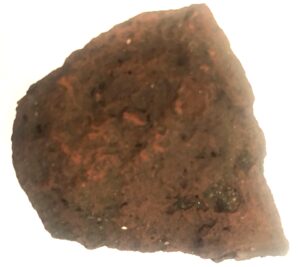Art Adventure • 7.08.2023 • Red Ochre
I expect some people will be relieved to know that I am not going to try to convert yellow ochre into red in my kitchen right now. The minimum temperature required is 500°C, not 500 °F. Or 200 °C. Or 300 °C. It’s just not that clear. I need to do more research to discover what fuel source and setup I need to achieve the higher temperatures (roughly 900 to 1600 °F) over a period of several hours.* BTW, the United States, Liberia, and the Cayman Islands are the only countries that use Fahrenheit. Some other countries use both; most use Centigrade. We should get with the program to avoid any more embarrassing errors.
The need for a very hot fire, however, is not urgent. I have found some natural red ochre!
One source I have been using is Peter Gleba’s 1978 Massachusetts Fossil and Mineral Locations. It is 138 pages of single-spaced typescript organized by county. Gleba sometimes gives coordinates and in other instances descriptions such as “Jewett farm (1838), north part of Rowley on road to Newbury.” A lot has happened in Massachusetts since 1978, and even more since 1838 (the date of the source of much of the information Gleba includes), so who knows which locations are accessible or even findable? On the other hand, you can search the PDF for terms such as“ochre,” “limonite,” and “hematite,” so you don’t have to read the whole publication to get some ideas about where to go.
A search of Cambridge locations yielded some no-longer-operating iron-smelting plants, locations of minerals in which I am not interested, and some clay deposits (one “under the HarvardUniversity Museum of Comparative Zoology”). Several of the latter had been identified in the trenches being dug for the sewer system around the turn of the last century. They might still be accessible when new trenches are dug for repairs. Ochre is sometimes defined as clay pigmented by hematite, so that info might eventually be useful. But no distinct ochre pits, mines, or deposits in Cambridge.
So I decided to go north to Essex County, partly because it’s nearby and partly because I am somewhat familiar with the area, having grown up there (but, as I said, A LOT has changed in more than five decades).
Using Gleba and following up by consulting websites such as mindat.org, I located a few promising spots—a closed iron mine in Georgetown, an ochre deposit on Jewett’s farm inRowley, and various minerals including malachite on Scribner’s Hill (or was it Atkins Hill, or are they the same hill?). in Georgetown. Gleba also noted a deposit of brown ochre and limonite at an “unknown location” in Georgetown. The first three sites seemed like good places to start, especially since my dear friend Abby Heim lives in Rowley and agreed to go prospecting with me.
We met at a coffee shop in Georgetown. I had found coordinates for the iron mine and some vaguer information on the location of Jewett’s Farm and Scribner’s (?) Hill. We reviewed the information, collected the shovel and trowel Abby had brought to complete the modern woman’s prospecting kit, and put on our boots to protect against ticks and snakes, both of which I am afraid of (terrified would be a better word for the snakes), and neither of which bothers Abby in the least, but she graciously went along with my precautions.
Before we looked for those three sites, though, I wanted to go back to a construction site I had passed on the way to Georgetown Crossing.
As I drove past the heaps of displaced earth, it had suddenly dawned on me that construction sites would be perfect places to hunt for ochre. Someone else had already done the digging! It wasn’t one of the spots we had intended to explore, but my theory is that if there are documented ochre deposits in an area, there is probably more ochre nearby. Maybe not enough to mine, but enough to collect for my purposes.

The site turned out to be a treasure trove of yellow and red ochre! We found so many specimens of rocks and soils of varying shades of yellow that we stopped picking them up. Red ochre wasn’t as copious, but we did find many pieces. It was sometime impossible to figure out which reds were actually ochre and which were rocks stained with iron that had leached out of nearby rocks, so we picked up most of the red we found.
We kept a lookout for the owners of the property and construction workers, but though we heard voices, we didn’t actually see anyone. Which is good because I am not sure our explanation of what we were doing would have justified trespassing to law enforcement. On the other hand, what police department would want to arrest two “mature” women with unknown quirks, medical issues, and food restrictions?
Having more than filled up ourTupperware, we headed for the iron mine, the site for which we had the best coordinates. As far as we could tell, it was in someone’s front yard and had been completely closed, since there was no visible sign of it at all. We had a shovel. But there’s trespassing…and then there’s trespassing.
A hiker suggested we try the trail on the opposite side of the road. There was a bog. More about bogs, swamps, ponds, and red ochre next time. We found more yellow and red rocks, but they did not seem to be different from the specimens we already had, so we left them.
It was time for lunch.
*If there are any alchemists, jewelers, ceramicists, glass artisans, or pizza chefs out there who could offer suggestions, I would be grateful.